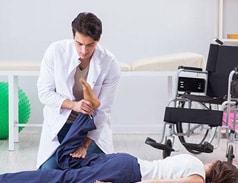Hey, I’m Shelley, from Miami Physio and Lakelands Physio, and today I’m going to talk to you about trigger finger – what is it, who is at risk, 4 exercises you can do at home, and when physio can help.
What is trigger finger?
Trigger finger is a rather common wrist and hand injury that we see. First, we need to understand how the fingers move. Each finger has muscles that attach to tendons running through pulleys so that you can individually open and close each finger. In trigger finger the affected tendon sheath (the covering around the tendon) becomes swollen and so the tendon can’t slide past the pulley well. Instead, it gets caught and irritated at the site of the pulley, and without treatment gets progressively worse.
The stages of trigger finger
First you might notice it is sore at the base of the finger or thumb, where the swollen tendon is rubbing against the pulley. You might feel a little nodule here.
The next stage, you’ll start to get triggering. This is where you bend your finger like into a fist, and when you go to straighten your hand, the finger movement catches or “triggers”, but you can still straighten it yourself.
In the next stage when you bend or close your hand and go to open it up, the finger stays bent and is stuck in this bent position. You have to use your other hand to straighten out your finger.
In the last stage, your finger gets stuck, and you can’t open it at all, even with the other hand.
Why do some people get trigger finger?
Women are six times more likely to get trigger finger, and it most commonly occurs in the 50s or 60s. In the normal population, your chance of developing trigger finger is 2-3%, but if you are diabetic, this increases to 10 %. It is also more common in people who have other hand conditions such as carpal tunnel, deQuervains disease, or have chronic illnesses including rheumatoid arthritis, gout, hypothyroidism, amyloidosis, and renal disease. It is thought that occupational habits and hobbies involving prolonged grasping/hand flexion may contribute.
So what now? If you think you have trigger finger, we can help as long as you are not in the permanently stuck stage. Watch our video, in there I show you 4 of the best exercises that may help.
The Four Home Exercises
First things first, it’s important to get a correct diagnosis from your physiotherapist. There are other hand conditions which are similar, and chronic health conditions that can co-exist – so managing your health is vital. Book in with one of our physiotherapists if you would like your hand checked out.
Now I’m going to show you 4 hand exercises to get you started on your home treatment.
Exercise #1: Duck beak
Firstly, rest your elbow on a flat surface so that you are not holding your arm up. You want to make a “duck beak” shape with your hands. ‘Close’ the duck’s beak and hold that pose while keeping your fingers straight for 3 seconds. Next, ‘open’ the beak by stretching your hand until your index finger and thumb nearly make a right angle. Repeat.
Exercise #2: Hooks
Keep your palm straight while straightening all fingers. Next, slowly curl your fingers downward. If you’re doing this properly, it should resemble a hook motion. Return your fingers to the starting position and repeat.
Exercise #3: Thumb to Fingertip touch and slide to base of each finger
The first step of this exercise is to touch your index finger to your thumb, as if you are making the “okay” symbol. Repeat for each finger. Once you have done that, you’re going to do the same thing but add on a slide. Gently slide your thumb down to the base of your finger cycle through your fingers once more.
Exercise #4: Flat hand on table finger spreading and squeeze together
Place your hand, palm-down, on a flat surface. Spread your digits apart and once they will go no further, bring them inwards and push them together.
Repeat each exercise 10 times, 3 times per day.
If you’re struggling to envision these exercises, watch our video above.
What else can you do?
We have researched the most up-to-date treatment approach for trigger finger, and after diagnosing this condition and testing the severity, we can offer treatment for people as long as they are not getting completing locking. Treatment in the clinic will include massage, joint mobilisations, shockwave therapy and sometimes splinting. This approach has a very high success rate for mild to moderate trigger finger. If yours is more severe, or you don’t respond to treatment as quickly as we expect, we will discuss other medical options which may help you.
If you have a trigger finger, or you know someone that does, it’s important to get it assessed. Leaving this condition untreated will cause it to get worse, and then treatment can take longer, or instead of conservative physiotherapy you may require injections or surgery. Call us at the clinics, or book online to have your finger assessed.

